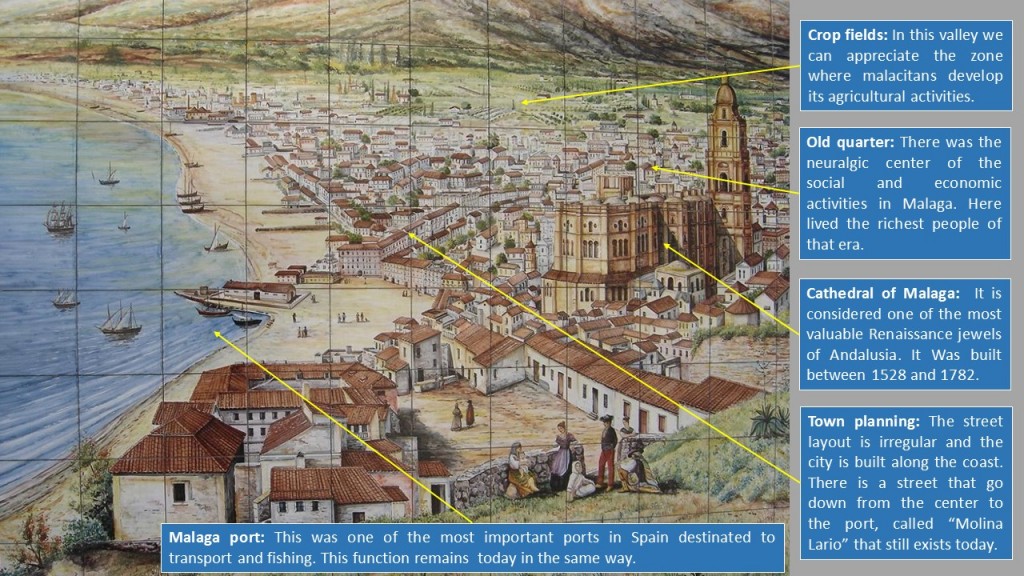MÁLAGA (18th Century)
This work of art is a mosaic of the city of Malaga, in Spain, from the 18th Century. Its author is unknown. It is made with painted ceramics, specifically 132 square pieces, and it is located in the wall of a tavern called “Chiringuito Escribano”, that we can find in the “Antonio Banderas Promenade”, located in this city. The author was inspired on the views from the top of an old quarter of Malaga called “La Coracha” to create this mosaic. Its most representative figure is the Cathedral of Malaga and in the background of the image we can see the urban structure of the city and the mountain that fortified it.
This image shows with a lot of details the type of houses and historical buildings along Malaga seaside and how they are laid in the ground. According to the urban structure, at the top and in the bottom right we can distinguish a number of crop fields; in the center, the old quarter of Malaga, on the left, the seaport and in the top left the suburbs. We can appreciate that the streets have not got an unique direction although the majority of them lead to the beach, so they are forming an irregular urban layout. This happens because the city was built along the coast, due to its complicated topography, as it is located into a valley between the mountains and the sea. In the center of the image, there is a street that goes up from the main entrance of the port to the city center, called “Molina Lario”.
Malaga is not only a city that based its economic activity on fishing. Also, one of its most important activities on that time was agriculture. It is caused because the city is located in the center of a bay surrounded by mountains. Its proximity to the sea promotes that the ground is more fertile. For this reason, in the background of the image we can appreciate some cultivated fields near to some houses that probably are farms. The most characteristic crops are oranges and lemons.
Obviously, the main attraction of the mosaic is the Cathedral of Malaga, that stands up practically in the city center. It is Renaissance, although it has some Gothic and Baroque details, and its real name is “Santa Iglesia Catedral Basílica de la Encarnación”. It is curious to note that the Cathedral of Malaga, once dedicated in 1588, was not completely finished until 200 years after. Around the Cathedral there are some houses belonging to the richest people of the city, because the buildings have more than one floor and there are located in the city center, in contrast with the houses that we can see in the outskirts, that are made with poor materials and only have the ground floor. To finish with the architecture, we can find near to the sea some buildings that are made specifically for fishing and shipping.
Concerning its economic activity, we can stand out as a curious fact that the fishing activity was not only conducted in the Mediterranean Sea, but also along the Guadalhorce River, that go across the city. Nowadays, due to pollution and the irregularity of its stream, fishing is impossible in the river. The species that the fishermen could find on the sea was anchovies, lobsters, shrimps, mackerels, soles, hakes, octopus and overall sardines.
Juan de la Calle Rivillo

